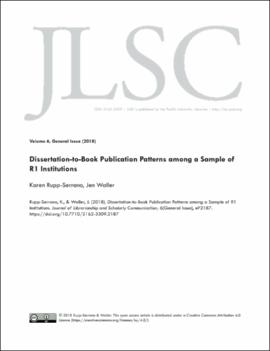| dc.contributor.author | Rupp-Serrano, Karen | |
| dc.contributor.author | Waller, Jen | |
| dc.date.accessioned | 2018-07-05T20:27:34Z | |
| dc.date.available | 2018-07-05T20:27:34Z | |
| dc.date.issued | 2018-05-18 | |
| dc.identifier.citation | Rupp-Serrano, K. & Waller, J., (2018). Dissertation-to-Book Publication Patterns Among a Sample of R1 Institutions. Journal of Librarianship and Scholarly Communication. 6(1), p.eP2187. DOI: http://doi.org/10.7710/2162-3309.2187 | en_US |
| dc.identifier.uri | https://hdl.handle.net/11244/300863 | |
| dc.description.abstract | INTRODUCTION: A common concern about openly available electronic theses and dissertations is that their “openness” will prevent graduate student authors from publishing their work commercially in the future. A handful of studies have explored aspects of this topic; this study reviewed dissertation-to-book publication patterns at Carnegie Classification R1 academic institutions. METHODS: This study analyzed over 23,000 dissertations from twelve U.S. universities to determine how frequently dissertations were subsequently published as books matching the original dissertation in pagination, chapters, and subject matter. WorldCat and several other resources were used to make publication determinations. RESULTS: Across the sample set, a very small percentage of dissertations were published as books that matched the original dissertation on pagination, chapters, and subject matter. The average number of years for dissertations in the study to be published as books was determined for broad subject categories and for select academic disciplines. Results were compared across public and private institutions, and books that were self-published or published by questionable organizations were identified. DISCUSSION: Dissertation-to-book trends occur primarily in the social sciences, humanities, and arts. With dissertations for which the author is actively working to publish as a book, the commonly offered 6- to 24-month embargo periods appear sufficient, provided that extensions or renewals continue to be available. CONCLUSION: This study has implications for librarians providing services to graduate students, faculty advisors, and graduate colleges/schools in regard to dissertation embargo lengths, self-publishing, and what we have termed questionable publishers, as these areas continue to provide opportunities for librarians to educate these stakeholders. | en_US |
| dc.language | en_US | en_US |
| dc.rights | Attribution 3.0 United States | * |
| dc.rights.uri | https://creativecommons.org/licenses/by/3.0/us/ | * |
| dc.subject | Information Science. | en_US |
| dc.subject | Education, Higher. | en_US |
| dc.subject | dissertations | en_US |
| dc.subject | book publishing | en_US |
| dc.subject | self publishing | en_US |
| dc.subject | questionable publishers | en_US |
| dc.subject | dissertation embargoes | en_US |
| dc.subject | ETD | en_US |
| dc.subject | open access | en_US |
| dc.subject | predatory publishers | en_US |
| dc.subject | scholarly publishing | en_US |
| dc.subject | scholarly communication | en_US |
| dc.title | Dissertation-to-Book Publication Patterns Among a Sample of R1 Institutions | en_US |
| dc.type | Article | en_US |
| dc.description.peerreview | Yes | en_US |
| dc.description.peerreviewnotes | JLSC uses a double anonymous review process for peer-reviewed submissions, meaning the authors' and reviewers' identities are not revealed to each other during review.
For articles where it would be difficult to fully anonymize the author, we allow authors to opt into a semi-anonymous review, where the author's affiliation is not anonymized in the manuscript. In no case is the author's name shared with the reviewers. Published articles will indicate which type of review the article underwent (semi- or fully anonymous).
The editor(s) will perform an initial review of all submitted manuscripts and may reject papers that are clearly outside of the scope of the journal. Manuscripts within the scope will be sent to at least two reviewers. Reviewers will not receive or be able to view any documentation or metadata that includes individually identifiable author information. Authors will be provided with similarly anonymized reviewer comments to aid in the revision of their manuscripts.
The review and revision process takes, on average, twelve weeks, with an initial decision within 5 weeks. Authors may not submit the manuscript to other publications while a review is in progress. | en_US |
| dc.identifier.doi | 10.7710/2162-3309.2187 | en_US |
| ou.group | Other | en_US |

